MGMT6011 - Strategic Management: A Case Study Analysis of Myer
VerifiedAdded on 2023/06/13
|20
|4139
|120
Case Study
AI Summary
This case study provides a comprehensive strategic analysis of Myer, a major Australian retailer, within a competitive environment. It begins with an introduction to Myer's current strategies aimed at improving efficiency and resilience, particularly in response to new market entrants like Amazon. The analysis then delves into the macro and industry environments using the PESTEL framework, examining political, economic, social, technological, environmental, and legal factors impacting Myer's operations. Key issues include the GST on imported goods, economic cycles, changing consumer preferences, technological advancements in online retail, and environmental sustainability. The study further assesses Myer's organizational strategy, performance (financial, customer, and internal), and capabilities, highlighting marketing, operational, and human resource considerations. Recommendations for Myer's future strategic direction are provided, supported by a VRIO analysis. The study concludes by emphasizing the importance of adapting to the evolving retail landscape and leveraging technological advancements to maintain a competitive edge. Desklib offers a range of study resources, including past papers and solved assignments, to support students in their academic pursuits.
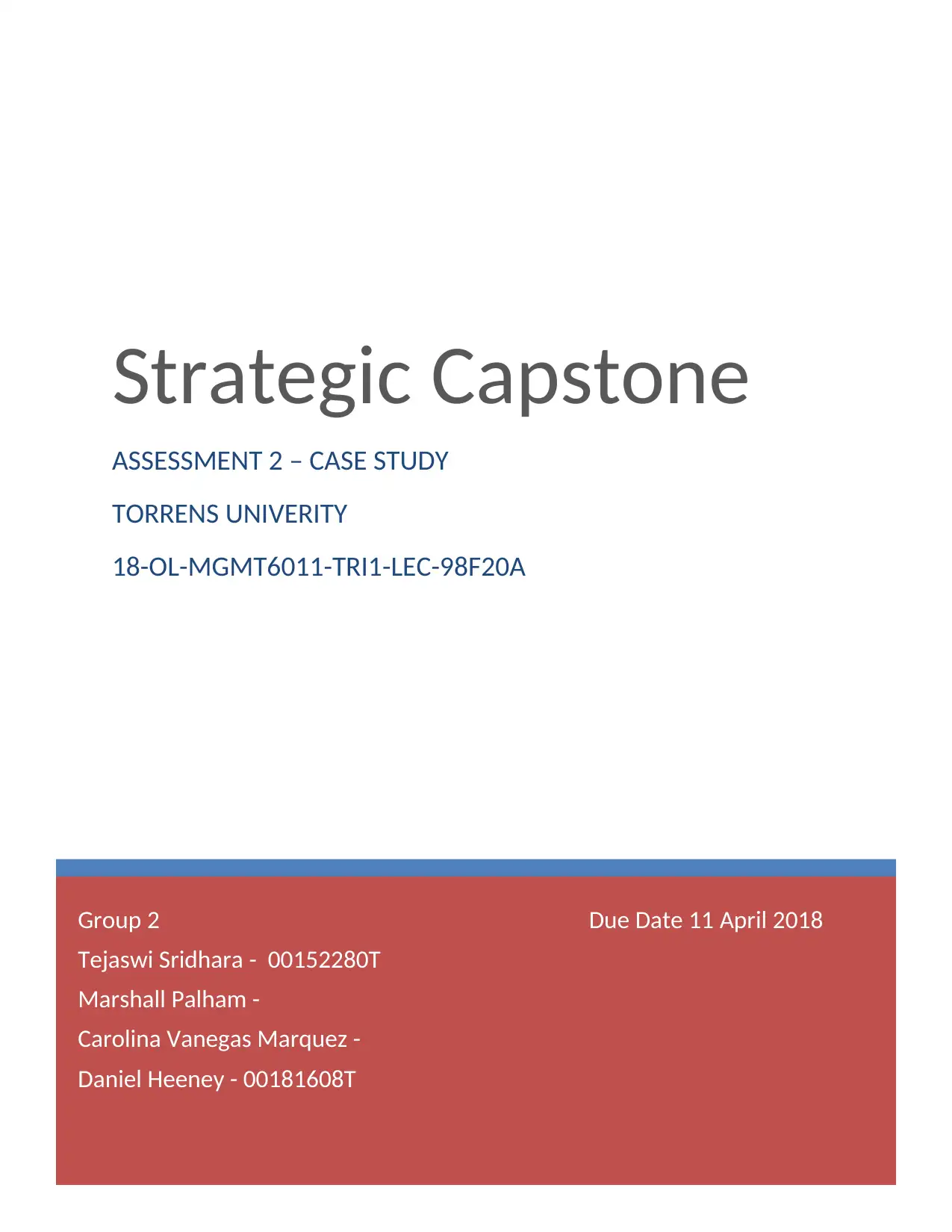
Strategic Capstone
ASSESSMENT 2 – CASE STUDY
TORRENS UNIVERITY
18-OL-MGMT6011-TRI1-LEC-98F20A
Group 2 Due Date 11 April 2018
Tejaswi Sridhara - 00152280T
Marshall Palham -
Carolina Vanegas Marquez -
Daniel Heeney - 00181608T
ASSESSMENT 2 – CASE STUDY
TORRENS UNIVERITY
18-OL-MGMT6011-TRI1-LEC-98F20A
Group 2 Due Date 11 April 2018
Tejaswi Sridhara - 00152280T
Marshall Palham -
Carolina Vanegas Marquez -
Daniel Heeney - 00181608T
Paraphrase This Document
Need a fresh take? Get an instant paraphrase of this document with our AI Paraphraser
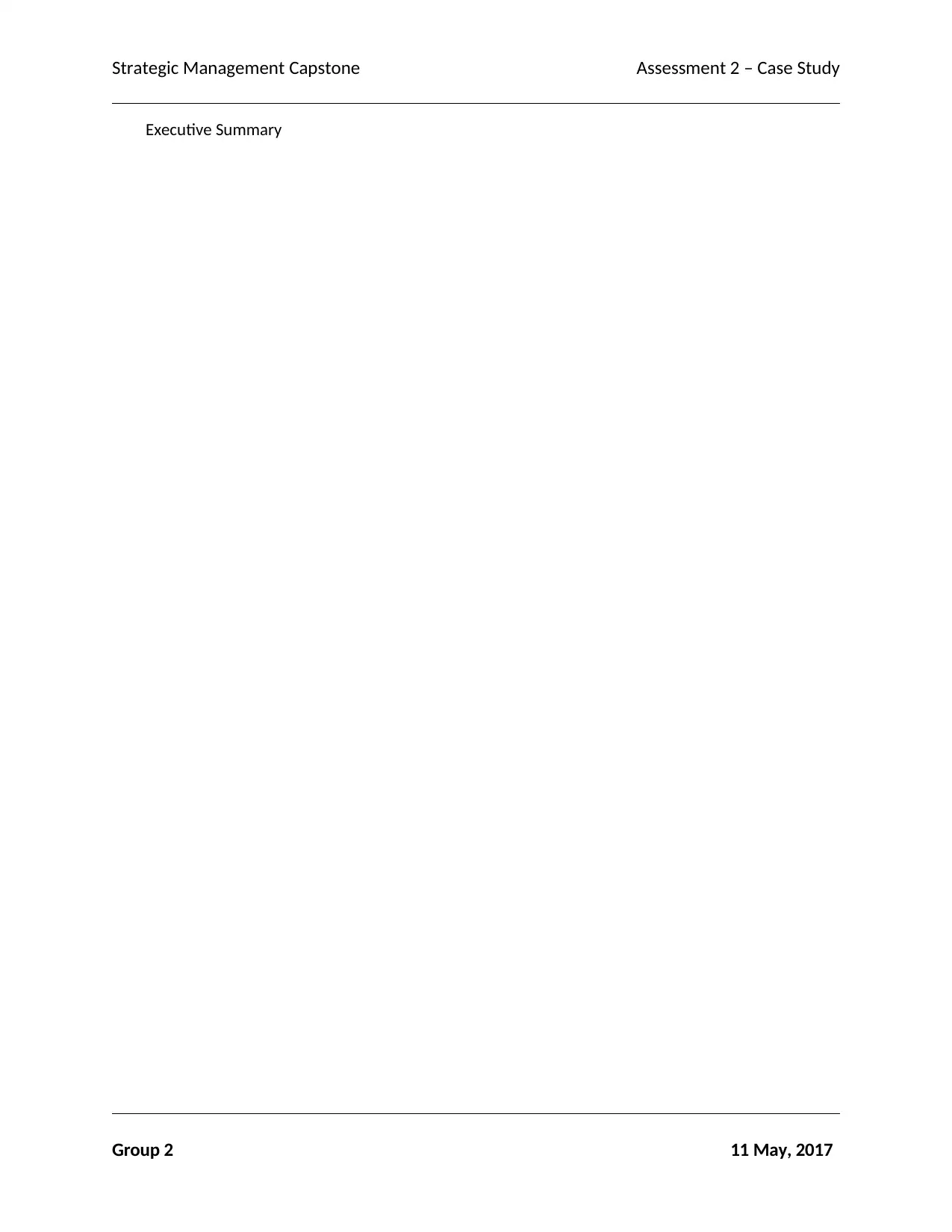
Strategic Management Capstone Assessment 2 – Case Study
Executive Summary
Group 2 11 May, 2017
Executive Summary
Group 2 11 May, 2017
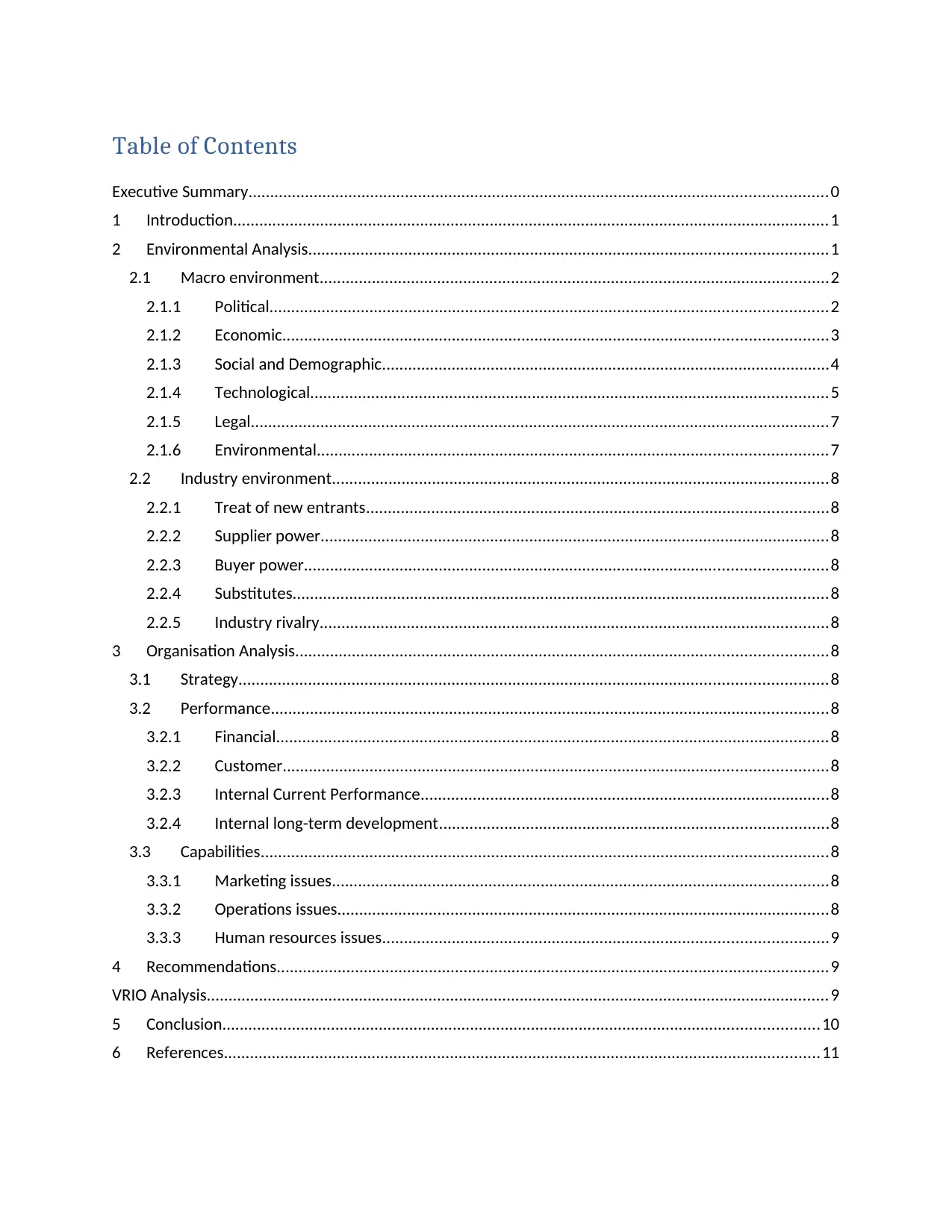
Table of Contents
Executive Summary.....................................................................................................................................0
1 Introduction.........................................................................................................................................1
2 Environmental Analysis.......................................................................................................................1
2.1 Macro environment.....................................................................................................................2
2.1.1 Political................................................................................................................................2
2.1.2 Economic.............................................................................................................................3
2.1.3 Social and Demographic.......................................................................................................4
2.1.4 Technological.......................................................................................................................5
2.1.5 Legal.....................................................................................................................................7
2.1.6 Environmental.....................................................................................................................7
2.2 Industry environment..................................................................................................................8
2.2.1 Treat of new entrants..........................................................................................................8
2.2.2 Supplier power.....................................................................................................................8
2.2.3 Buyer power........................................................................................................................8
2.2.4 Substitutes...........................................................................................................................8
2.2.5 Industry rivalry.....................................................................................................................8
3 Organisation Analysis..........................................................................................................................8
3.1 Strategy.......................................................................................................................................8
3.2 Performance................................................................................................................................8
3.2.1 Financial...............................................................................................................................8
3.2.2 Customer.............................................................................................................................8
3.2.3 Internal Current Performance..............................................................................................8
3.2.4 Internal long-term development.........................................................................................8
3.3 Capabilities..................................................................................................................................8
3.3.1 Marketing issues..................................................................................................................8
3.3.2 Operations issues.................................................................................................................8
3.3.3 Human resources issues......................................................................................................9
4 Recommendations...............................................................................................................................9
VRIO Analysis...............................................................................................................................................9
5 Conclusion.........................................................................................................................................10
6 References.........................................................................................................................................11
Executive Summary.....................................................................................................................................0
1 Introduction.........................................................................................................................................1
2 Environmental Analysis.......................................................................................................................1
2.1 Macro environment.....................................................................................................................2
2.1.1 Political................................................................................................................................2
2.1.2 Economic.............................................................................................................................3
2.1.3 Social and Demographic.......................................................................................................4
2.1.4 Technological.......................................................................................................................5
2.1.5 Legal.....................................................................................................................................7
2.1.6 Environmental.....................................................................................................................7
2.2 Industry environment..................................................................................................................8
2.2.1 Treat of new entrants..........................................................................................................8
2.2.2 Supplier power.....................................................................................................................8
2.2.3 Buyer power........................................................................................................................8
2.2.4 Substitutes...........................................................................................................................8
2.2.5 Industry rivalry.....................................................................................................................8
3 Organisation Analysis..........................................................................................................................8
3.1 Strategy.......................................................................................................................................8
3.2 Performance................................................................................................................................8
3.2.1 Financial...............................................................................................................................8
3.2.2 Customer.............................................................................................................................8
3.2.3 Internal Current Performance..............................................................................................8
3.2.4 Internal long-term development.........................................................................................8
3.3 Capabilities..................................................................................................................................8
3.3.1 Marketing issues..................................................................................................................8
3.3.2 Operations issues.................................................................................................................8
3.3.3 Human resources issues......................................................................................................9
4 Recommendations...............................................................................................................................9
VRIO Analysis...............................................................................................................................................9
5 Conclusion.........................................................................................................................................10
6 References.........................................................................................................................................11
⊘ This is a preview!⊘
Do you want full access?
Subscribe today to unlock all pages.

Trusted by 1+ million students worldwide
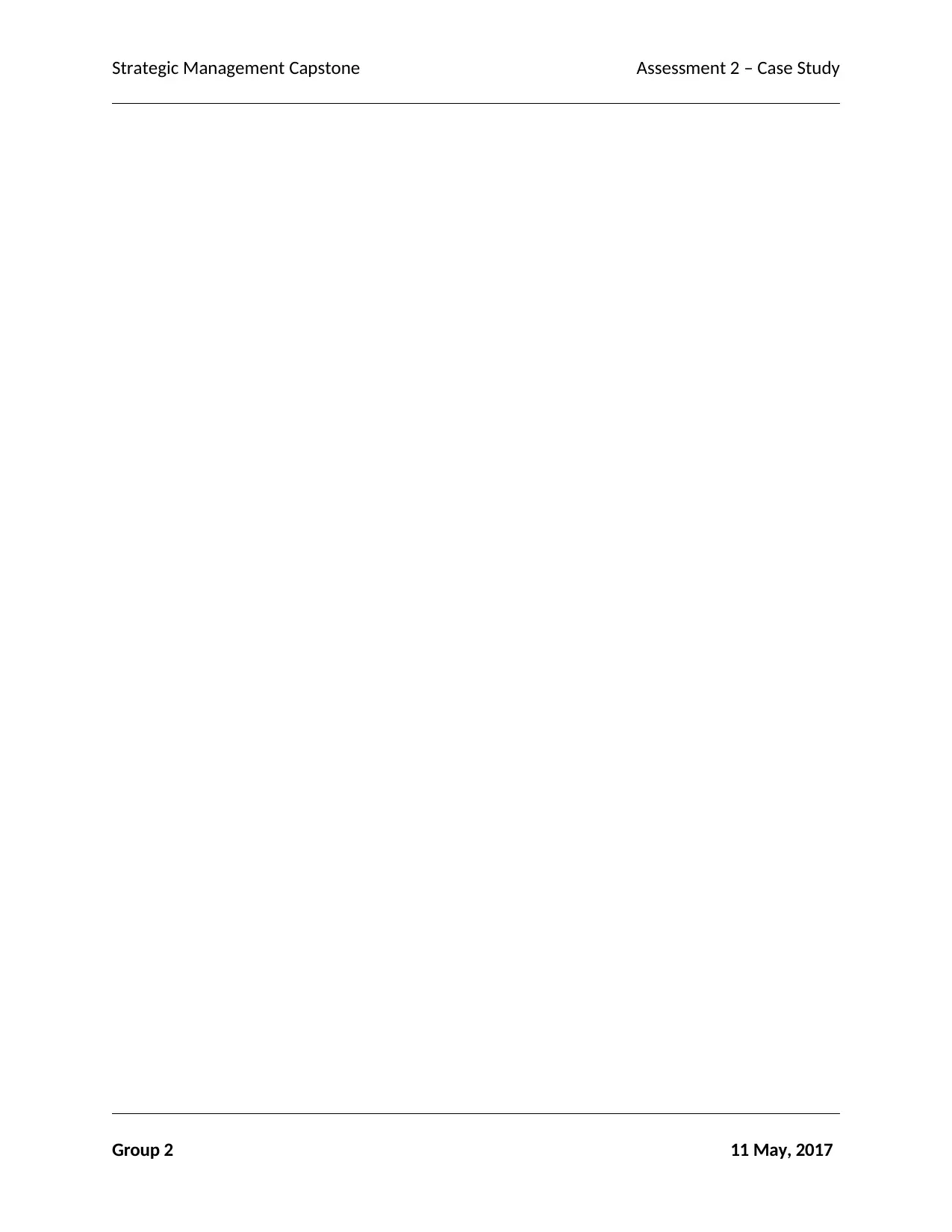
Strategic Management Capstone Assessment 2 – Case Study
Group 2 11 May, 2017
Group 2 11 May, 2017
Paraphrase This Document
Need a fresh take? Get an instant paraphrase of this document with our AI Paraphraser
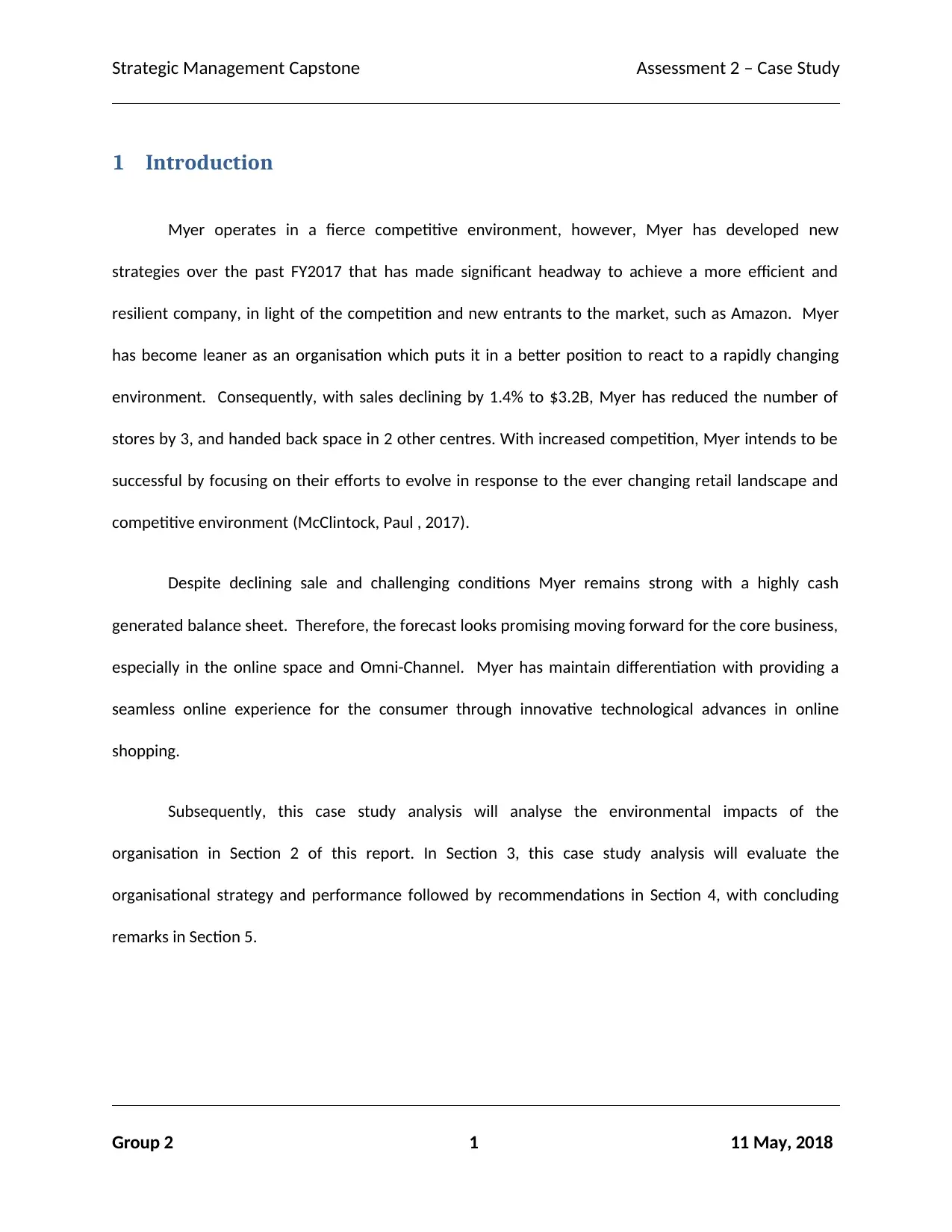
Strategic Management Capstone Assessment 2 – Case Study
1 Introduction
Myer operates in a fierce competitive environment, however, Myer has developed new
strategies over the past FY2017 that has made significant headway to achieve a more efficient and
resilient company, in light of the competition and new entrants to the market, such as Amazon. Myer
has become leaner as an organisation which puts it in a better position to react to a rapidly changing
environment. Consequently, with sales declining by 1.4% to $3.2B, Myer has reduced the number of
stores by 3, and handed back space in 2 other centres. With increased competition, Myer intends to be
successful by focusing on their efforts to evolve in response to the ever changing retail landscape and
competitive environment (McClintock, Paul , 2017).
Despite declining sale and challenging conditions Myer remains strong with a highly cash
generated balance sheet. Therefore, the forecast looks promising moving forward for the core business,
especially in the online space and Omni-Channel. Myer has maintain differentiation with providing a
seamless online experience for the consumer through innovative technological advances in online
shopping.
Subsequently, this case study analysis will analyse the environmental impacts of the
organisation in Section 2 of this report. In Section 3, this case study analysis will evaluate the
organisational strategy and performance followed by recommendations in Section 4, with concluding
remarks in Section 5.
Group 2 1 11 May, 2018
1 Introduction
Myer operates in a fierce competitive environment, however, Myer has developed new
strategies over the past FY2017 that has made significant headway to achieve a more efficient and
resilient company, in light of the competition and new entrants to the market, such as Amazon. Myer
has become leaner as an organisation which puts it in a better position to react to a rapidly changing
environment. Consequently, with sales declining by 1.4% to $3.2B, Myer has reduced the number of
stores by 3, and handed back space in 2 other centres. With increased competition, Myer intends to be
successful by focusing on their efforts to evolve in response to the ever changing retail landscape and
competitive environment (McClintock, Paul , 2017).
Despite declining sale and challenging conditions Myer remains strong with a highly cash
generated balance sheet. Therefore, the forecast looks promising moving forward for the core business,
especially in the online space and Omni-Channel. Myer has maintain differentiation with providing a
seamless online experience for the consumer through innovative technological advances in online
shopping.
Subsequently, this case study analysis will analyse the environmental impacts of the
organisation in Section 2 of this report. In Section 3, this case study analysis will evaluate the
organisational strategy and performance followed by recommendations in Section 4, with concluding
remarks in Section 5.
Group 2 1 11 May, 2018
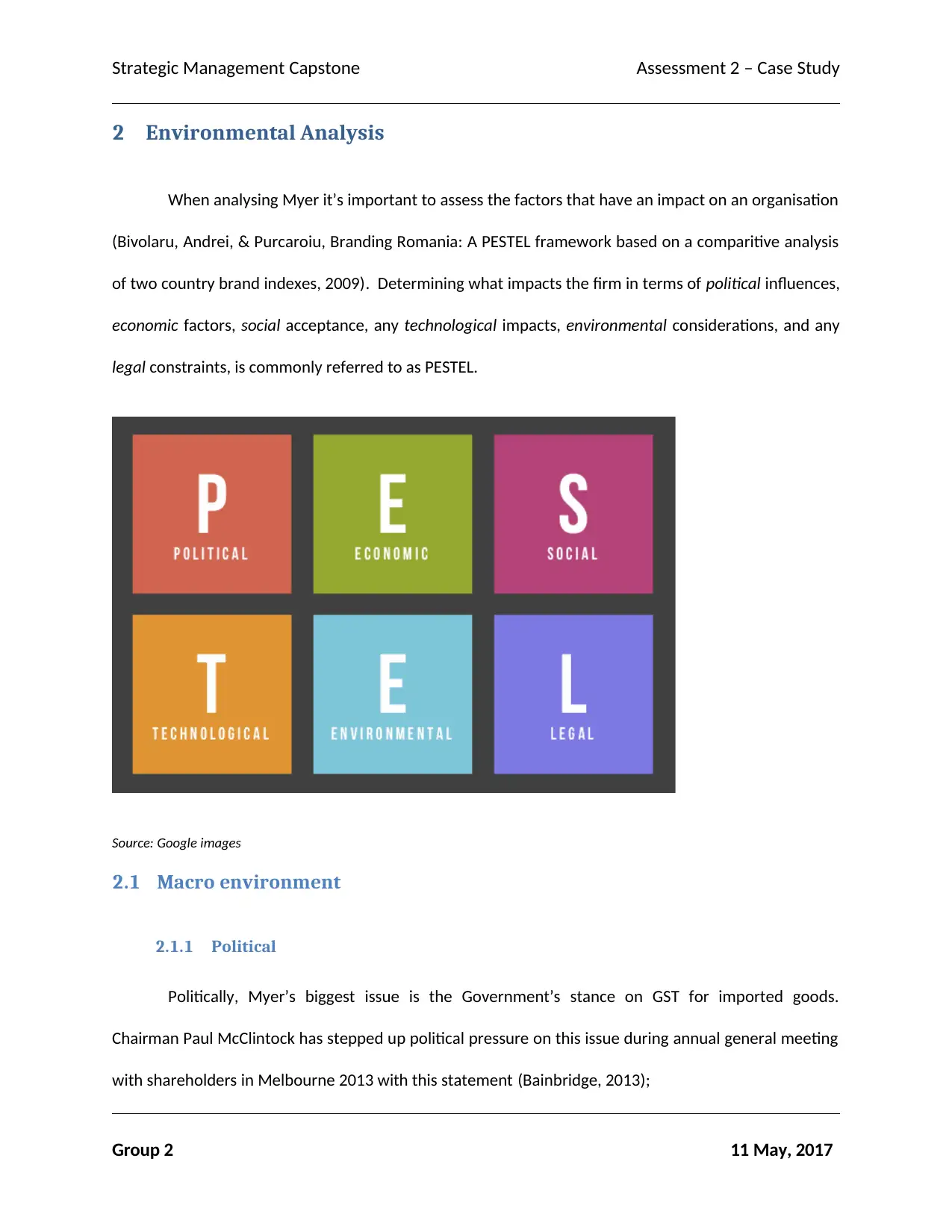
Strategic Management Capstone Assessment 2 – Case Study
2 Environmental Analysis
When analysing Myer it’s important to assess the factors that have an impact on an organisation
(Bivolaru, Andrei, & Purcaroiu, Branding Romania: A PESTEL framework based on a comparitive analysis
of two country brand indexes, 2009). Determining what impacts the firm in terms of political influences,
economic factors, social acceptance, any technological impacts, environmental considerations, and any
legal constraints, is commonly referred to as PESTEL.
Source: Google images
2.1 Macro environment
2.1.1 Political
Politically, Myer’s biggest issue is the Government’s stance on GST for imported goods.
Chairman Paul McClintock has stepped up political pressure on this issue during annual general meeting
with shareholders in Melbourne 2013 with this statement (Bainbridge, 2013);
Group 2 11 May, 2017
2 Environmental Analysis
When analysing Myer it’s important to assess the factors that have an impact on an organisation
(Bivolaru, Andrei, & Purcaroiu, Branding Romania: A PESTEL framework based on a comparitive analysis
of two country brand indexes, 2009). Determining what impacts the firm in terms of political influences,
economic factors, social acceptance, any technological impacts, environmental considerations, and any
legal constraints, is commonly referred to as PESTEL.
Source: Google images
2.1 Macro environment
2.1.1 Political
Politically, Myer’s biggest issue is the Government’s stance on GST for imported goods.
Chairman Paul McClintock has stepped up political pressure on this issue during annual general meeting
with shareholders in Melbourne 2013 with this statement (Bainbridge, 2013);
Group 2 11 May, 2017
⊘ This is a preview!⊘
Do you want full access?
Subscribe today to unlock all pages.

Trusted by 1+ million students worldwide
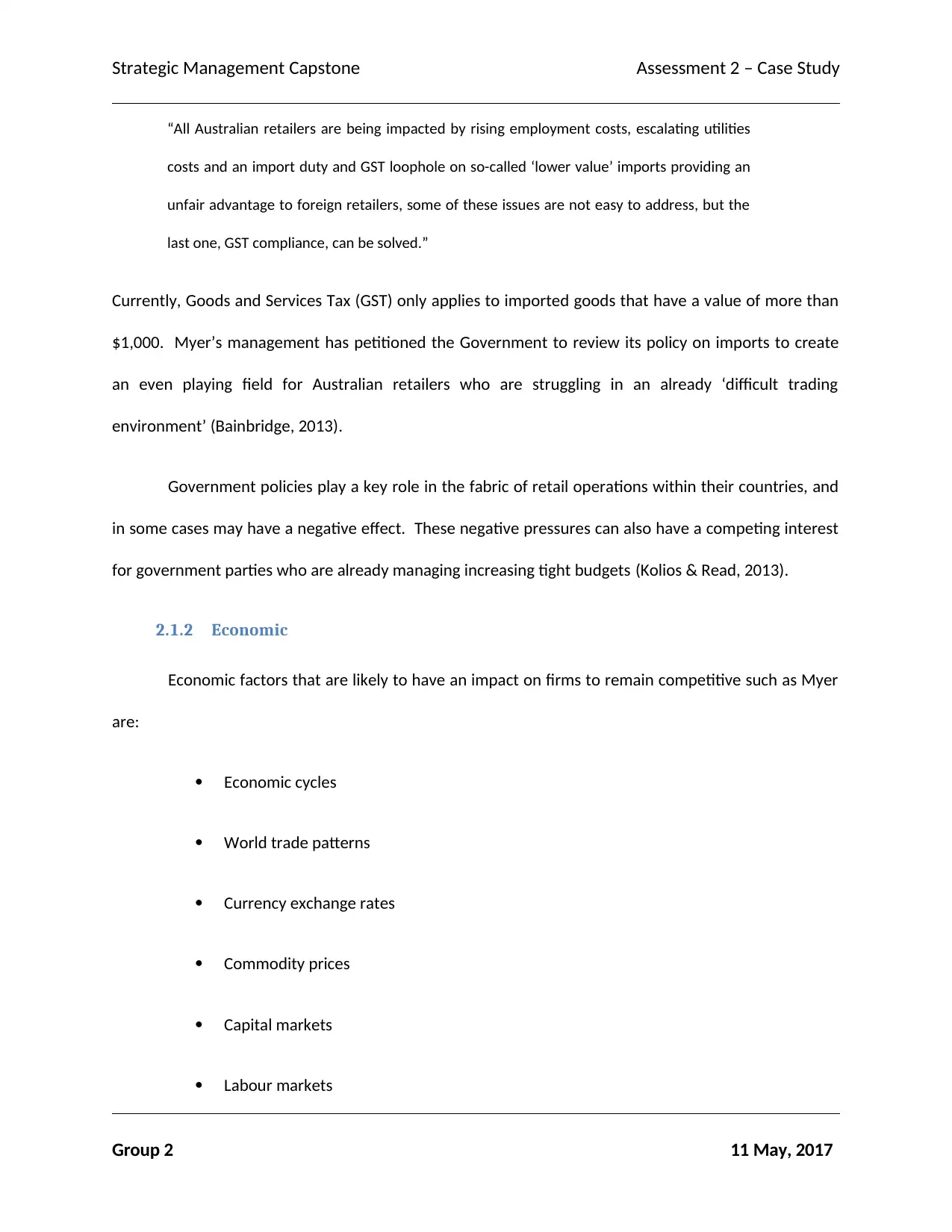
Strategic Management Capstone Assessment 2 – Case Study
“All Australian retailers are being impacted by rising employment costs, escalating utilities
costs and an import duty and GST loophole on so-called ‘lower value’ imports providing an
unfair advantage to foreign retailers, some of these issues are not easy to address, but the
last one, GST compliance, can be solved.”
Currently, Goods and Services Tax (GST) only applies to imported goods that have a value of more than
$1,000. Myer’s management has petitioned the Government to review its policy on imports to create
an even playing field for Australian retailers who are struggling in an already ‘difficult trading
environment’ (Bainbridge, 2013).
Government policies play a key role in the fabric of retail operations within their countries, and
in some cases may have a negative effect. These negative pressures can also have a competing interest
for government parties who are already managing increasing tight budgets (Kolios & Read, 2013).
2.1.2 Economic
Economic factors that are likely to have an impact on firms to remain competitive such as Myer
are:
Economic cycles
World trade patterns
Currency exchange rates
Commodity prices
Capital markets
Labour markets
Group 2 11 May, 2017
“All Australian retailers are being impacted by rising employment costs, escalating utilities
costs and an import duty and GST loophole on so-called ‘lower value’ imports providing an
unfair advantage to foreign retailers, some of these issues are not easy to address, but the
last one, GST compliance, can be solved.”
Currently, Goods and Services Tax (GST) only applies to imported goods that have a value of more than
$1,000. Myer’s management has petitioned the Government to review its policy on imports to create
an even playing field for Australian retailers who are struggling in an already ‘difficult trading
environment’ (Bainbridge, 2013).
Government policies play a key role in the fabric of retail operations within their countries, and
in some cases may have a negative effect. These negative pressures can also have a competing interest
for government parties who are already managing increasing tight budgets (Kolios & Read, 2013).
2.1.2 Economic
Economic factors that are likely to have an impact on firms to remain competitive such as Myer
are:
Economic cycles
World trade patterns
Currency exchange rates
Commodity prices
Capital markets
Labour markets
Group 2 11 May, 2017
Paraphrase This Document
Need a fresh take? Get an instant paraphrase of this document with our AI Paraphraser
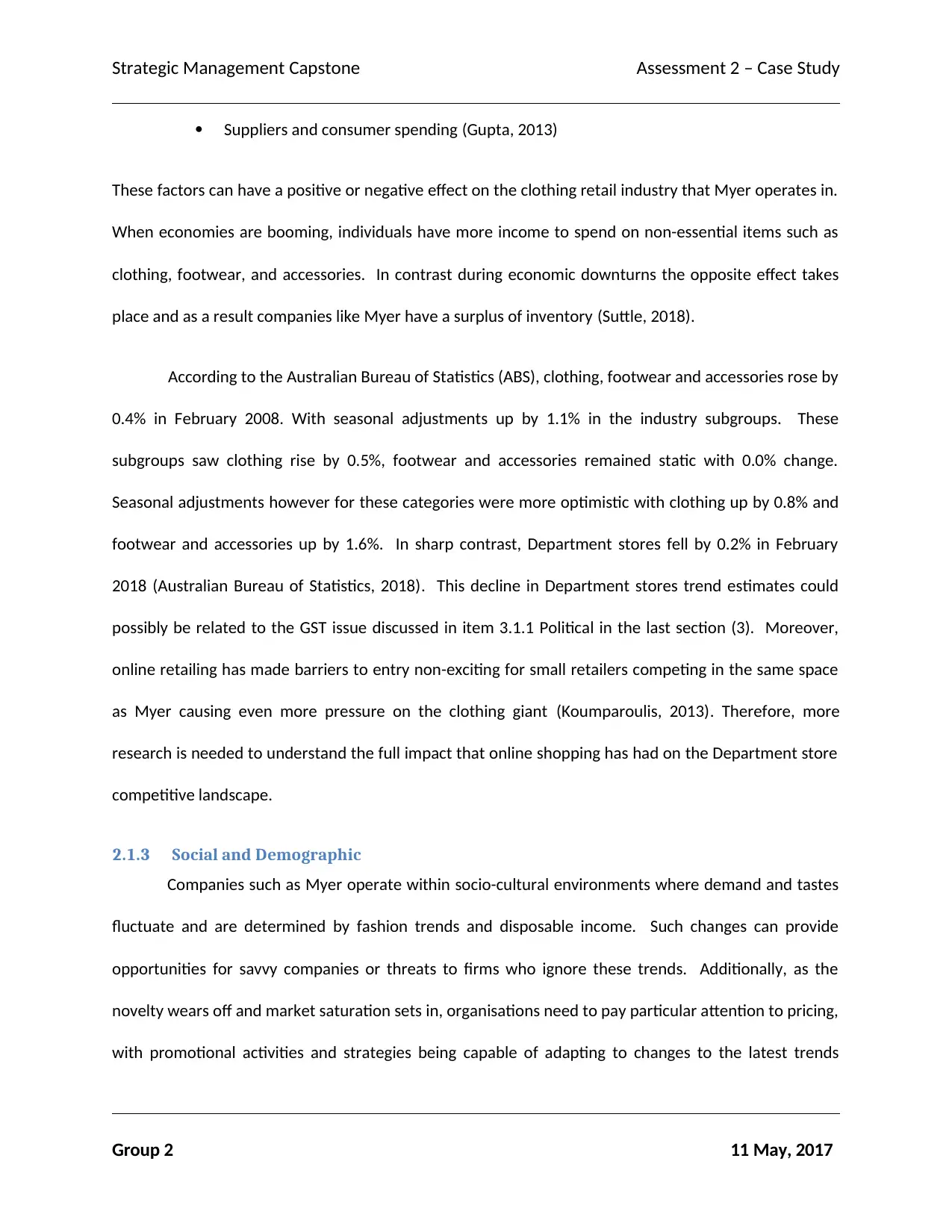
Strategic Management Capstone Assessment 2 – Case Study
Suppliers and consumer spending (Gupta, 2013)
These factors can have a positive or negative effect on the clothing retail industry that Myer operates in.
When economies are booming, individuals have more income to spend on non-essential items such as
clothing, footwear, and accessories. In contrast during economic downturns the opposite effect takes
place and as a result companies like Myer have a surplus of inventory (Suttle, 2018).
According to the Australian Bureau of Statistics (ABS), clothing, footwear and accessories rose by
0.4% in February 2008. With seasonal adjustments up by 1.1% in the industry subgroups. These
subgroups saw clothing rise by 0.5%, footwear and accessories remained static with 0.0% change.
Seasonal adjustments however for these categories were more optimistic with clothing up by 0.8% and
footwear and accessories up by 1.6%. In sharp contrast, Department stores fell by 0.2% in February
2018 (Australian Bureau of Statistics, 2018). This decline in Department stores trend estimates could
possibly be related to the GST issue discussed in item 3.1.1 Political in the last section (3). Moreover,
online retailing has made barriers to entry non-exciting for small retailers competing in the same space
as Myer causing even more pressure on the clothing giant (Koumparoulis, 2013). Therefore, more
research is needed to understand the full impact that online shopping has had on the Department store
competitive landscape.
2.1.3 Social and Demographic
Companies such as Myer operate within socio-cultural environments where demand and tastes
fluctuate and are determined by fashion trends and disposable income. Such changes can provide
opportunities for savvy companies or threats to firms who ignore these trends. Additionally, as the
novelty wears off and market saturation sets in, organisations need to pay particular attention to pricing,
with promotional activities and strategies being capable of adapting to changes to the latest trends
Group 2 11 May, 2017
Suppliers and consumer spending (Gupta, 2013)
These factors can have a positive or negative effect on the clothing retail industry that Myer operates in.
When economies are booming, individuals have more income to spend on non-essential items such as
clothing, footwear, and accessories. In contrast during economic downturns the opposite effect takes
place and as a result companies like Myer have a surplus of inventory (Suttle, 2018).
According to the Australian Bureau of Statistics (ABS), clothing, footwear and accessories rose by
0.4% in February 2008. With seasonal adjustments up by 1.1% in the industry subgroups. These
subgroups saw clothing rise by 0.5%, footwear and accessories remained static with 0.0% change.
Seasonal adjustments however for these categories were more optimistic with clothing up by 0.8% and
footwear and accessories up by 1.6%. In sharp contrast, Department stores fell by 0.2% in February
2018 (Australian Bureau of Statistics, 2018). This decline in Department stores trend estimates could
possibly be related to the GST issue discussed in item 3.1.1 Political in the last section (3). Moreover,
online retailing has made barriers to entry non-exciting for small retailers competing in the same space
as Myer causing even more pressure on the clothing giant (Koumparoulis, 2013). Therefore, more
research is needed to understand the full impact that online shopping has had on the Department store
competitive landscape.
2.1.3 Social and Demographic
Companies such as Myer operate within socio-cultural environments where demand and tastes
fluctuate and are determined by fashion trends and disposable income. Such changes can provide
opportunities for savvy companies or threats to firms who ignore these trends. Additionally, as the
novelty wears off and market saturation sets in, organisations need to pay particular attention to pricing,
with promotional activities and strategies being capable of adapting to changes to the latest trends
Group 2 11 May, 2017
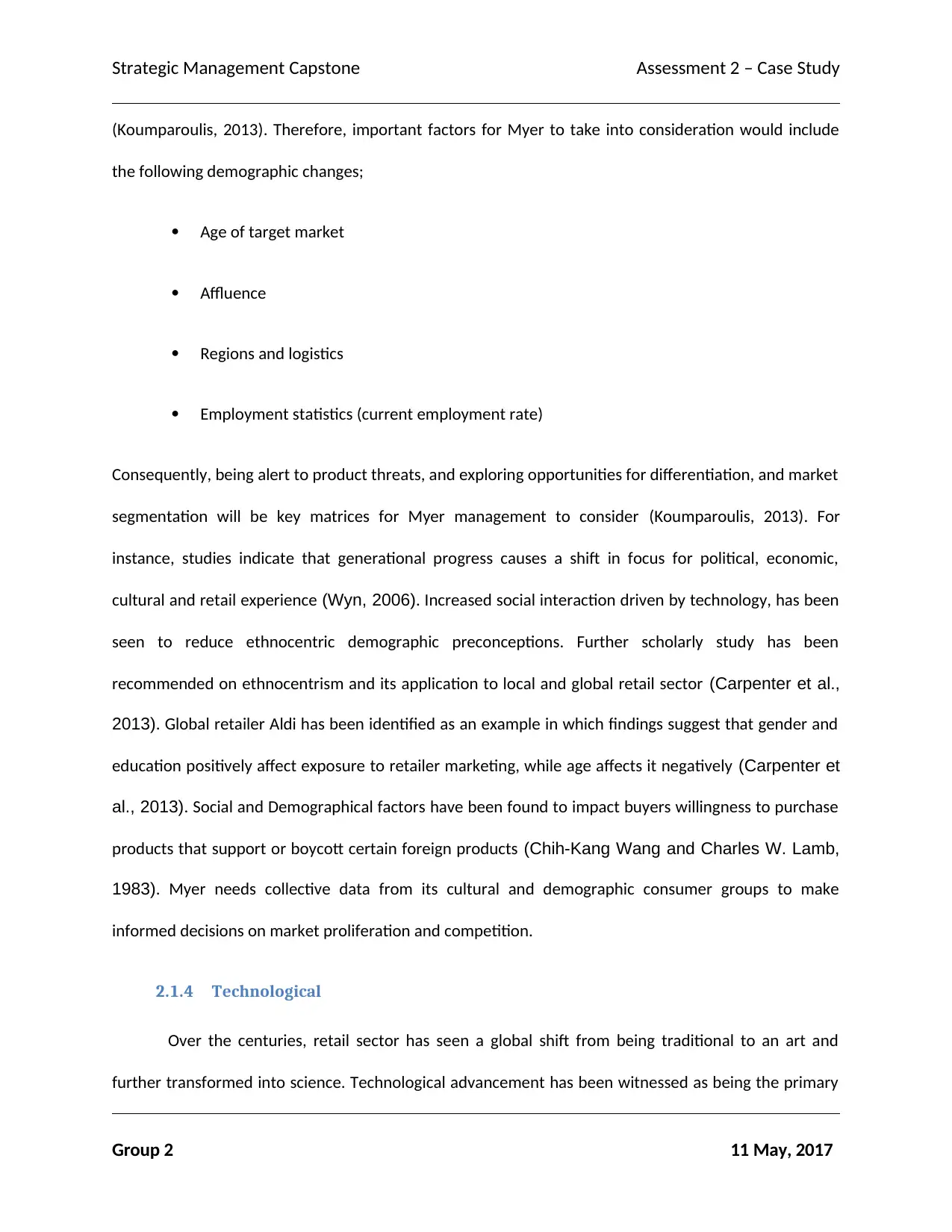
Strategic Management Capstone Assessment 2 – Case Study
(Koumparoulis, 2013). Therefore, important factors for Myer to take into consideration would include
the following demographic changes;
Age of target market
Affluence
Regions and logistics
Employment statistics (current employment rate)
Consequently, being alert to product threats, and exploring opportunities for differentiation, and market
segmentation will be key matrices for Myer management to consider (Koumparoulis, 2013). For
instance, studies indicate that generational progress causes a shift in focus for political, economic,
cultural and retail experience (Wyn, 2006). Increased social interaction driven by technology, has been
seen to reduce ethnocentric demographic preconceptions. Further scholarly study has been
recommended on ethnocentrism and its application to local and global retail sector (Carpenter et al.,
2013). Global retailer Aldi has been identified as an example in which findings suggest that gender and
education positively affect exposure to retailer marketing, while age affects it negatively (Carpenter et
al., 2013). Social and Demographical factors have been found to impact buyers willingness to purchase
products that support or boycott certain foreign products (Chih-Kang Wang and Charles W. Lamb,
1983). Myer needs collective data from its cultural and demographic consumer groups to make
informed decisions on market proliferation and competition.
2.1.4 Technological
Over the centuries, retail sector has seen a global shift from being traditional to an art and
further transformed into science. Technological advancement has been witnessed as being the primary
Group 2 11 May, 2017
(Koumparoulis, 2013). Therefore, important factors for Myer to take into consideration would include
the following demographic changes;
Age of target market
Affluence
Regions and logistics
Employment statistics (current employment rate)
Consequently, being alert to product threats, and exploring opportunities for differentiation, and market
segmentation will be key matrices for Myer management to consider (Koumparoulis, 2013). For
instance, studies indicate that generational progress causes a shift in focus for political, economic,
cultural and retail experience (Wyn, 2006). Increased social interaction driven by technology, has been
seen to reduce ethnocentric demographic preconceptions. Further scholarly study has been
recommended on ethnocentrism and its application to local and global retail sector (Carpenter et al.,
2013). Global retailer Aldi has been identified as an example in which findings suggest that gender and
education positively affect exposure to retailer marketing, while age affects it negatively (Carpenter et
al., 2013). Social and Demographical factors have been found to impact buyers willingness to purchase
products that support or boycott certain foreign products (Chih-Kang Wang and Charles W. Lamb,
1983). Myer needs collective data from its cultural and demographic consumer groups to make
informed decisions on market proliferation and competition.
2.1.4 Technological
Over the centuries, retail sector has seen a global shift from being traditional to an art and
further transformed into science. Technological advancement has been witnessed as being the primary
Group 2 11 May, 2017
⊘ This is a preview!⊘
Do you want full access?
Subscribe today to unlock all pages.

Trusted by 1+ million students worldwide
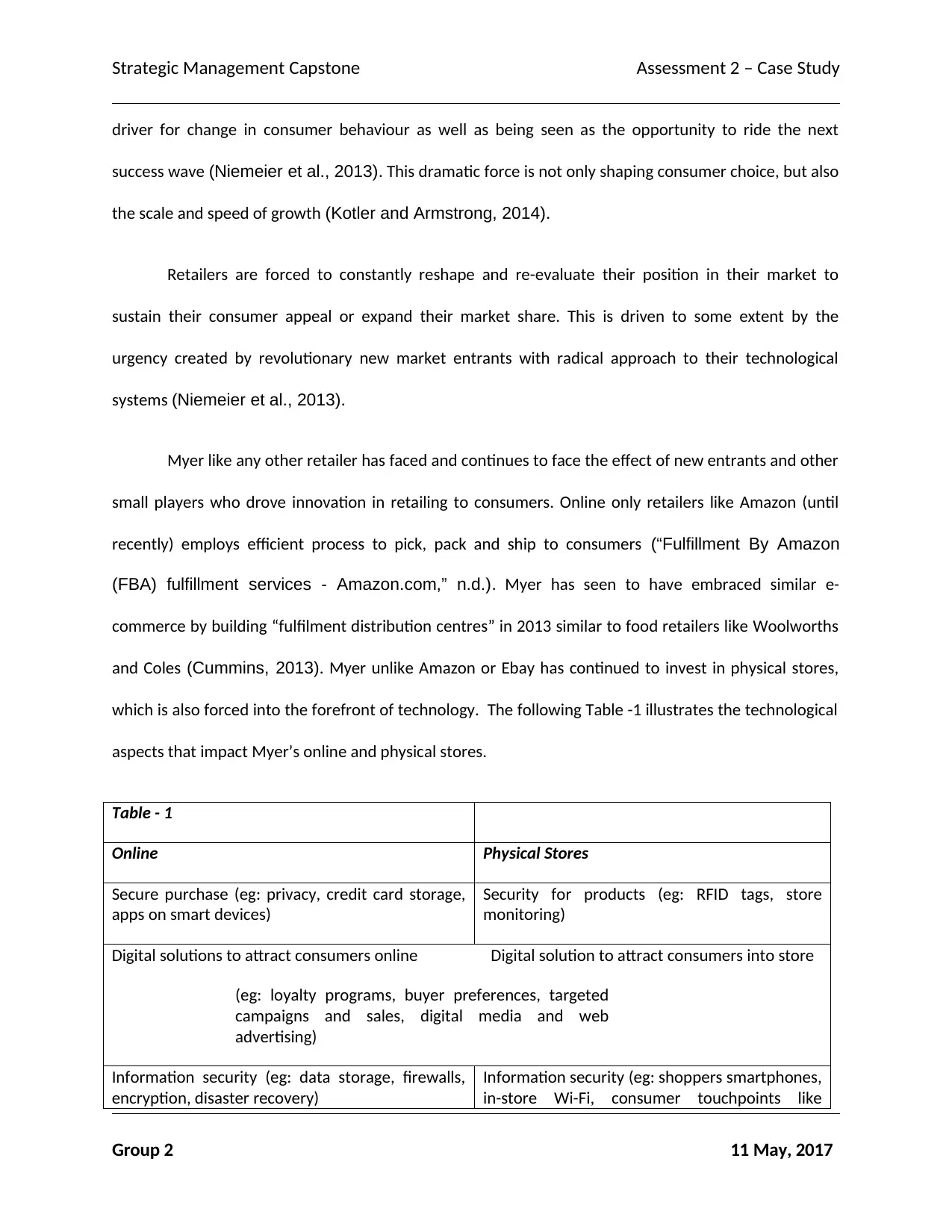
Strategic Management Capstone Assessment 2 – Case Study
driver for change in consumer behaviour as well as being seen as the opportunity to ride the next
success wave (Niemeier et al., 2013). This dramatic force is not only shaping consumer choice, but also
the scale and speed of growth (Kotler and Armstrong, 2014).
Retailers are forced to constantly reshape and re-evaluate their position in their market to
sustain their consumer appeal or expand their market share. This is driven to some extent by the
urgency created by revolutionary new market entrants with radical approach to their technological
systems (Niemeier et al., 2013).
Myer like any other retailer has faced and continues to face the effect of new entrants and other
small players who drove innovation in retailing to consumers. Online only retailers like Amazon (until
recently) employs efficient process to pick, pack and ship to consumers (“Fulfillment By Amazon
(FBA) fulfillment services - Amazon.com,” n.d.). Myer has seen to have embraced similar e-
commerce by building “fulfilment distribution centres” in 2013 similar to food retailers like Woolworths
and Coles (Cummins, 2013). Myer unlike Amazon or Ebay has continued to invest in physical stores,
which is also forced into the forefront of technology. The following Table -1 illustrates the technological
aspects that impact Myer’s online and physical stores.
Table - 1
Online Physical Stores
Secure purchase (eg: privacy, credit card storage,
apps on smart devices)
Security for products (eg: RFID tags, store
monitoring)
Digital solutions to attract consumers online Digital solution to attract consumers into store
(eg: loyalty programs, buyer preferences, targeted
campaigns and sales, digital media and web
advertising)
Information security (eg: data storage, firewalls,
encryption, disaster recovery)
Information security (eg: shoppers smartphones,
in-store Wi-Fi, consumer touchpoints like
Group 2 11 May, 2017
driver for change in consumer behaviour as well as being seen as the opportunity to ride the next
success wave (Niemeier et al., 2013). This dramatic force is not only shaping consumer choice, but also
the scale and speed of growth (Kotler and Armstrong, 2014).
Retailers are forced to constantly reshape and re-evaluate their position in their market to
sustain their consumer appeal or expand their market share. This is driven to some extent by the
urgency created by revolutionary new market entrants with radical approach to their technological
systems (Niemeier et al., 2013).
Myer like any other retailer has faced and continues to face the effect of new entrants and other
small players who drove innovation in retailing to consumers. Online only retailers like Amazon (until
recently) employs efficient process to pick, pack and ship to consumers (“Fulfillment By Amazon
(FBA) fulfillment services - Amazon.com,” n.d.). Myer has seen to have embraced similar e-
commerce by building “fulfilment distribution centres” in 2013 similar to food retailers like Woolworths
and Coles (Cummins, 2013). Myer unlike Amazon or Ebay has continued to invest in physical stores,
which is also forced into the forefront of technology. The following Table -1 illustrates the technological
aspects that impact Myer’s online and physical stores.
Table - 1
Online Physical Stores
Secure purchase (eg: privacy, credit card storage,
apps on smart devices)
Security for products (eg: RFID tags, store
monitoring)
Digital solutions to attract consumers online Digital solution to attract consumers into store
(eg: loyalty programs, buyer preferences, targeted
campaigns and sales, digital media and web
advertising)
Information security (eg: data storage, firewalls,
encryption, disaster recovery)
Information security (eg: shoppers smartphones,
in-store Wi-Fi, consumer touchpoints like
Group 2 11 May, 2017
Paraphrase This Document
Need a fresh take? Get an instant paraphrase of this document with our AI Paraphraser
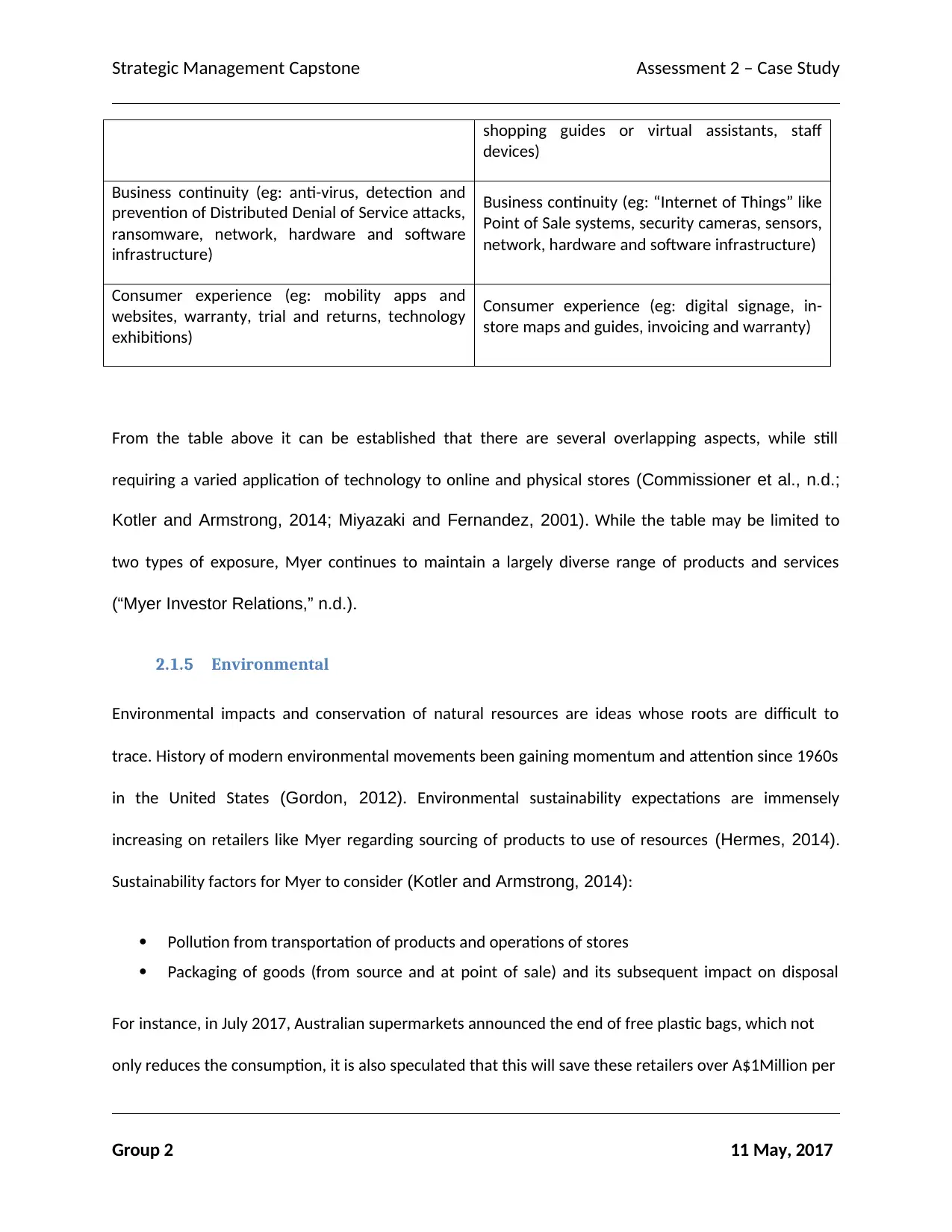
Strategic Management Capstone Assessment 2 – Case Study
shopping guides or virtual assistants, staff
devices)
Business continuity (eg: anti-virus, detection and
prevention of Distributed Denial of Service attacks,
ransomware, network, hardware and software
infrastructure)
Business continuity (eg: “Internet of Things” like
Point of Sale systems, security cameras, sensors,
network, hardware and software infrastructure)
Consumer experience (eg: mobility apps and
websites, warranty, trial and returns, technology
exhibitions)
Consumer experience (eg: digital signage, in-
store maps and guides, invoicing and warranty)
From the table above it can be established that there are several overlapping aspects, while still
requiring a varied application of technology to online and physical stores (Commissioner et al., n.d.;
Kotler and Armstrong, 2014; Miyazaki and Fernandez, 2001). While the table may be limited to
two types of exposure, Myer continues to maintain a largely diverse range of products and services
(“Myer Investor Relations,” n.d.).
2.1.5 Environmental
Environmental impacts and conservation of natural resources are ideas whose roots are difficult to
trace. History of modern environmental movements been gaining momentum and attention since 1960s
in the United States (Gordon, 2012). Environmental sustainability expectations are immensely
increasing on retailers like Myer regarding sourcing of products to use of resources (Hermes, 2014).
Sustainability factors for Myer to consider (Kotler and Armstrong, 2014):
Pollution from transportation of products and operations of stores
Packaging of goods (from source and at point of sale) and its subsequent impact on disposal
For instance, in July 2017, Australian supermarkets announced the end of free plastic bags, which not
only reduces the consumption, it is also speculated that this will save these retailers over A$1Million per
Group 2 11 May, 2017
shopping guides or virtual assistants, staff
devices)
Business continuity (eg: anti-virus, detection and
prevention of Distributed Denial of Service attacks,
ransomware, network, hardware and software
infrastructure)
Business continuity (eg: “Internet of Things” like
Point of Sale systems, security cameras, sensors,
network, hardware and software infrastructure)
Consumer experience (eg: mobility apps and
websites, warranty, trial and returns, technology
exhibitions)
Consumer experience (eg: digital signage, in-
store maps and guides, invoicing and warranty)
From the table above it can be established that there are several overlapping aspects, while still
requiring a varied application of technology to online and physical stores (Commissioner et al., n.d.;
Kotler and Armstrong, 2014; Miyazaki and Fernandez, 2001). While the table may be limited to
two types of exposure, Myer continues to maintain a largely diverse range of products and services
(“Myer Investor Relations,” n.d.).
2.1.5 Environmental
Environmental impacts and conservation of natural resources are ideas whose roots are difficult to
trace. History of modern environmental movements been gaining momentum and attention since 1960s
in the United States (Gordon, 2012). Environmental sustainability expectations are immensely
increasing on retailers like Myer regarding sourcing of products to use of resources (Hermes, 2014).
Sustainability factors for Myer to consider (Kotler and Armstrong, 2014):
Pollution from transportation of products and operations of stores
Packaging of goods (from source and at point of sale) and its subsequent impact on disposal
For instance, in July 2017, Australian supermarkets announced the end of free plastic bags, which not
only reduces the consumption, it is also speculated that this will save these retailers over A$1Million per
Group 2 11 May, 2017
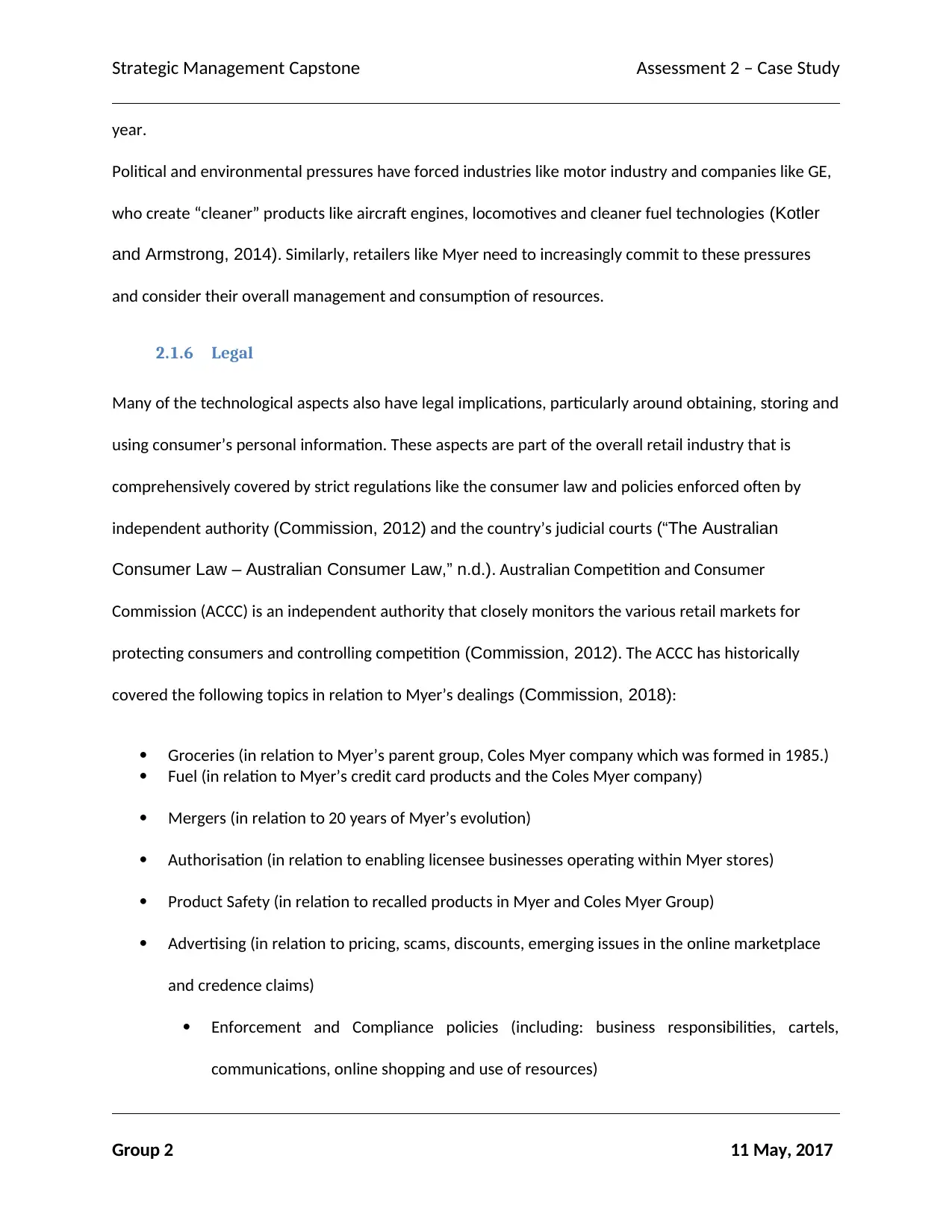
Strategic Management Capstone Assessment 2 – Case Study
year.
Political and environmental pressures have forced industries like motor industry and companies like GE,
who create “cleaner” products like aircraft engines, locomotives and cleaner fuel technologies (Kotler
and Armstrong, 2014). Similarly, retailers like Myer need to increasingly commit to these pressures
and consider their overall management and consumption of resources.
2.1.6 Legal
Many of the technological aspects also have legal implications, particularly around obtaining, storing and
using consumer’s personal information. These aspects are part of the overall retail industry that is
comprehensively covered by strict regulations like the consumer law and policies enforced often by
independent authority (Commission, 2012) and the country’s judicial courts (“The Australian
Consumer Law – Australian Consumer Law,” n.d.). Australian Competition and Consumer
Commission (ACCC) is an independent authority that closely monitors the various retail markets for
protecting consumers and controlling competition (Commission, 2012). The ACCC has historically
covered the following topics in relation to Myer’s dealings (Commission, 2018):
Groceries (in relation to Myer’s parent group, Coles Myer company which was formed in 1985.)
Fuel (in relation to Myer’s credit card products and the Coles Myer company)
Mergers (in relation to 20 years of Myer’s evolution)
Authorisation (in relation to enabling licensee businesses operating within Myer stores)
Product Safety (in relation to recalled products in Myer and Coles Myer Group)
Advertising (in relation to pricing, scams, discounts, emerging issues in the online marketplace
and credence claims)
Enforcement and Compliance policies (including: business responsibilities, cartels,
communications, online shopping and use of resources)
Group 2 11 May, 2017
year.
Political and environmental pressures have forced industries like motor industry and companies like GE,
who create “cleaner” products like aircraft engines, locomotives and cleaner fuel technologies (Kotler
and Armstrong, 2014). Similarly, retailers like Myer need to increasingly commit to these pressures
and consider their overall management and consumption of resources.
2.1.6 Legal
Many of the technological aspects also have legal implications, particularly around obtaining, storing and
using consumer’s personal information. These aspects are part of the overall retail industry that is
comprehensively covered by strict regulations like the consumer law and policies enforced often by
independent authority (Commission, 2012) and the country’s judicial courts (“The Australian
Consumer Law – Australian Consumer Law,” n.d.). Australian Competition and Consumer
Commission (ACCC) is an independent authority that closely monitors the various retail markets for
protecting consumers and controlling competition (Commission, 2012). The ACCC has historically
covered the following topics in relation to Myer’s dealings (Commission, 2018):
Groceries (in relation to Myer’s parent group, Coles Myer company which was formed in 1985.)
Fuel (in relation to Myer’s credit card products and the Coles Myer company)
Mergers (in relation to 20 years of Myer’s evolution)
Authorisation (in relation to enabling licensee businesses operating within Myer stores)
Product Safety (in relation to recalled products in Myer and Coles Myer Group)
Advertising (in relation to pricing, scams, discounts, emerging issues in the online marketplace
and credence claims)
Enforcement and Compliance policies (including: business responsibilities, cartels,
communications, online shopping and use of resources)
Group 2 11 May, 2017
⊘ This is a preview!⊘
Do you want full access?
Subscribe today to unlock all pages.

Trusted by 1+ million students worldwide
1 out of 20
Related Documents
Your All-in-One AI-Powered Toolkit for Academic Success.
+13062052269
info@desklib.com
Available 24*7 on WhatsApp / Email
![[object Object]](/_next/static/media/star-bottom.7253800d.svg)
Unlock your academic potential
Copyright © 2020–2025 A2Z Services. All Rights Reserved. Developed and managed by ZUCOL.




